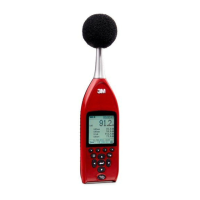Measure
Positioning and tripod mount
Sound Examiner SE-400 Series
Positioning and tripod mount
For area monitoring and general sound level sessions, hand-held measurements are conducted by positioning
the microphone directly at the noise source.
To perform stationary sound level measurements, a tripod may be used by connecting the SE-400 Series to
the tripod mount while positioning it at a 0-degree incidence angle.
Figure 4-7: Measurement positioning and tripod mount
Measurements and displayed parameters
The measurements and labels which appear on the display will change based on the selected frequency
weighting and response time. For example, A-weighting and Slow Response will display the following labels:
LASmx, LASmn, LASeq, and L
AE
. The frequency weighting and response time are customizable within DMS
(software). The selectable measurements are explained below. (Please see Glossary of Terms in Appendix
B for more information).
Measurement/
e level – is the basic measurement of noise loudness, expressed in decibels. SPL
measured with A-weighting and slow time response is displayed as “LAS” or “SPL”.
Maximum sound pressure level
with A-weighting and slow response. (Displayed when in run or
Peak sound pressure level with A-weighting. (Displayed when in run or stop modes.)
Average sound pressure level
with 3,4, or 5 dB exchange rate. (Displayed when in run or stop
Minimum SPL with C-weighting and slow response. (Displayed when in run or stop modes.)
Sound Exposure Level (SEL) or Level Exposure (LE) – The sound exposure level averages the
sampled sound over a one second period. Assuming the sampled run time to be greater than one
second, S
EL is the equivalent one-second noise that would be equal in energy to the noise that was
sampled. SEL is typically measured using a 3dB exchange rate without a threshold. (L
Table 4-1: Measurement notations

